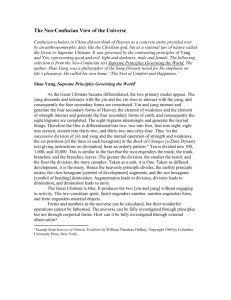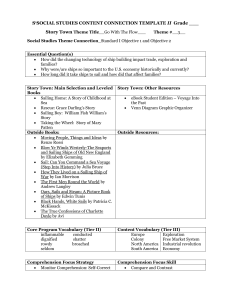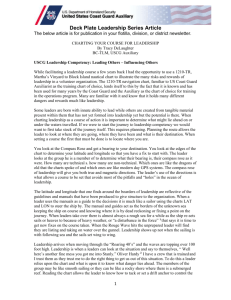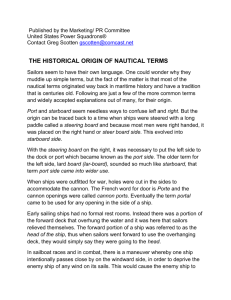Laws of Dialectics in Technology Evolution
advertisement
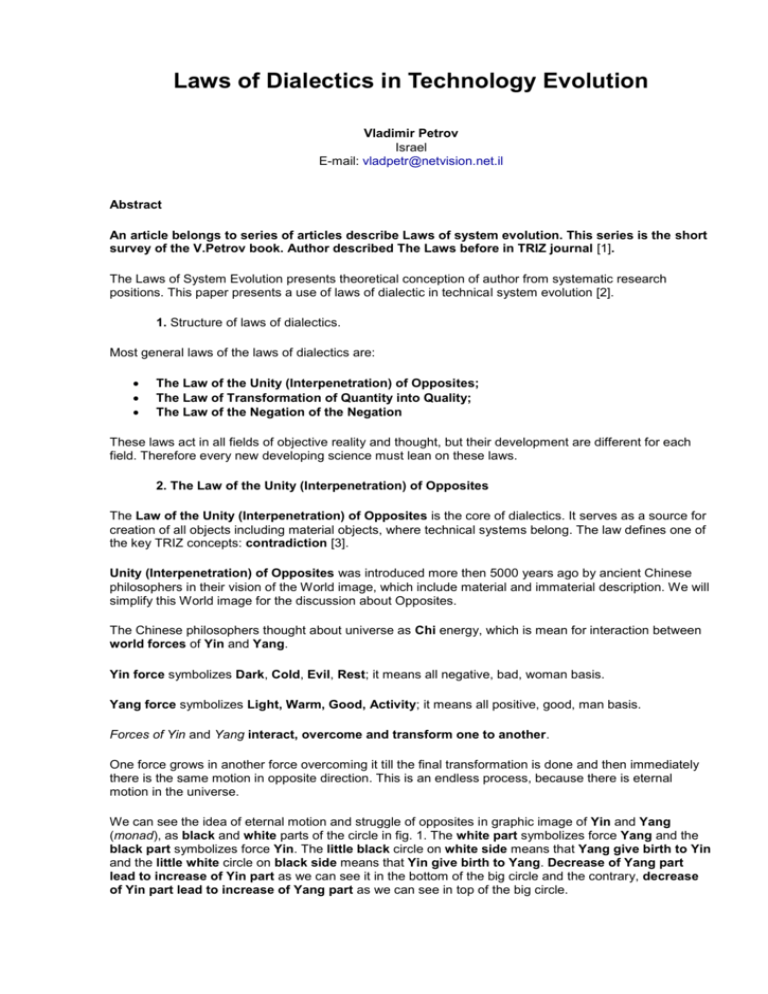
Laws of Dialectics in Technology Evolution Vladimir Petrov Israel E-mail: vladpetr@netvision.net.il Abstract An article belongs to series of articles describe Laws of system evolution. This series is the short survey of the V.Petrov book. Author described The Laws before in TRIZ journal [1]. The Laws of System Evolution presents theoretical conception of author from systematic research positions. This paper presents a use of laws of dialectic in technical system evolution [2]. 1. Structure of laws of dialectics. Most general laws of the laws of dialectics are: The Law of the Unity (Interpenetration) of Opposites; The Law of Transformation of Quantity into Quality; The Law of the Negation of the Negation These laws act in all fields of objective reality and thought, but their development are different for each field. Therefore every new developing science must lean on these laws. 2. The Law of the Unity (Interpenetration) of Opposites The Law of the Unity (Interpenetration) of Opposites is the core of dialectics. It serves as a source for creation of all objects including material objects, where technical systems belong. The law defines one of the key TRIZ concepts: contradiction [3]. Unity (Interpenetration) of Opposites was introduced more then 5000 years ago by ancient Chinese philosophers in their vision of the World image, which include material and immaterial description. We will simplify this World image for the discussion about Opposites. The Chinese philosophers thought about universe as Chi energy, which is mean for interaction between world forces of Yin and Yang. Yin force symbolizes Dark, Cold, Evil, Rest; it means all negative, bad, woman basis. Yang force symbolizes Light, Warm, Good, Activity; it means all positive, good, man basis. Forces of Yin and Yang interact, overcome and transform one to another. One force grows in another force overcoming it till the final transformation is done and then immediately there is the same motion in opposite direction. This is an endless process, because there is eternal motion in the universe. We can see the idea of eternal motion and struggle of opposites in graphic image of Yin and Yang (monad), as black and white parts of the circle in fig. 1. The white part symbolizes force Yang and the black part symbolizes force Yin. The little black circle on white side means that Yang give birth to Yin and the little white circle on black side means that Yin give birth to Yang. Decrease of Yang part lead to increase of Yin part as we can see it in the bottom of the big circle and the contrary, decrease of Yin part lead to increase of Yang part as we can see in top of the big circle. This image shows interaction and struggle of the opposites. In the monad the interaction and struggle of opposites in the system are in balance, cataclysms are not occurred. We can say there is a balance in nature when there is no storm, tornado, fire, flood, ecological disorder etc, or balance in society, when there is no war, or balance in mechanism when it is without breakdown, failure etc. In the state of balance the system functions in the most favorable conditions without negative internal or external impacts. With system’s one side change, there is system’s other side change. Sometimes it causes the antagonisms. For example if we improve some system’s parameter it makes other parameter worse. The contradictive action or quality can be born as a result of structural change. The same picture 1 shows the possibility of contradictive qualities separation in space (Yin on the right side and Yang on the left side) and in structure (the small part of Yin is inside of Yang and vice versa). Moreover, space division can be done by any curve or surface. 3. Law of Transformation of Quantity into Quality The Law of Transformation of Quantity into Quality defines a general mechanism of evolution. Quantitative changes in a system take place continuously accordingly the S-curve of evolution. When a certain limit of quantitative evolution is reached, a system experiences qualitative changes. New quality increases rate of growth. During this process, quantitative changes take place continuously whereas qualitative changes take place in discrete steps. The duration and character of the discrete step can differ: long and short, impetuous and relatively calm and so on. There are 4 growth stages to pass for any technical system. (see fig. 2) At the beginning, the development is slow (stage I), at the certain point there is an acceleration in development speed (stage II), after that the speed is slowing down till the parameter’s growth of system is finished (stage III), this means appearance of the contradictions. Sometimes the parameters begin to decrease; it means the death of the current system (stage IV). The curves like these so-called “line of life of a technical system”, usually called S-curves. For technical system: Stage I - born of the system (idea and prototype) Stage II - industrial manufacturing of the system and it development accordingly to market demands Stage III - final touch of little improvements, the main parameters of the system doesn’t change, there is mostly the cosmetic changes (package and appearance) Stage IV - worsening of certain system parameters, caused by: - economical, social or political situation influence, mode, religious limitation etc. - physical and moral ageing of system usually in stage IV the system end it existence or become utilized End of system growth doesn’t mean end of evolution in this field. The new more advanced systems come to life, what means leap forward in evolution take place. Further evolution of the system starts according to a new S-curve. This is a typical example of Law of Transformation of Quantity into Quality. Such a process we can see in picture 3. System 2 appears instead of system 1. The leap forward in evolution continues, in the same way appears system 3 after it system 4 and so on. The whole progress in the field can be seen as a tangent to the S-curves (dashed line in picture 4) so-called envelope curve. Development of any kind of technology can be an example for the support of this law. Let’s see the shipbuilding technology. Example 1: Suppose the speed of the ship will be the P parameter. The speed growth of rowing boat was done by increase in number of oars, but it couldn’t exceed the 7-8 miles. Leap forward in evolution - appearance of sailing vessel. Speed growth there was done by increase of overall sail’s square, but it couldn’t exceed the 12-13 miles. That wasn’t enough; there was a need to increase the speed without dependence in speed and direction of the wind. Therefore: Next leap forward in evolution - ships with engine. The speed growth of ships with engine was done by increase the power density of the engine. The next leap was the displacement of tonnage part of the ship out of water. This causes the ships with underwater wings. After that was needed to decrease water resistance to these wings - appeared ships on air cushion. More decrease in water resistance to ship lead to airfoil boat. Example 2. Rowing boat. The overall tendency of rowing boat development is given in fig. 5. At the beginning was only one oar. Then was the incensement in number of oars. At the beginning there was only one tier. The incensement in number of oars led to reorganization it to two, three and even five tiers of oarsman. Example 3. Sailing vessel. The overall tendency of sailing vessel development is given in picture 6. At the beginning was only one sail on mast. After that was the incensement in number of sails and masts. Example 4. The speed growth of ships and the need of independence from wind led to next leap forward in evolution - appearance of engine ship. The speed growth in this kind of ships was done by perfection of engine and replacement to more power density types. First of all there was a steam engine, after that diesel, then steam or gas turbine and finally nuclear plant. Example 5. The next leap was the displacement of tonnage part of the ship out of water. This causes the ships with underwater wings. Example 6. After that was needed to decrease water resistance to these wings - appeared ships on air cushion. Example 7. Finally, more decrease in water resistance to ship lead to airfoil boat (fig. 7). This kind of ships is alike airplane, flying above the water, using shadow effect supporting the ship. It can carry load much more then the airplane. In the phase of problem choice and for system evolution forecasting there is a need of taking into account the Law of Transformation of Quantity into Quality. To imagine a full diagram of evolution of technical systems, it is necessary to take into account a so-called “line of life” of a technical system [4], a regularity defined by Genrich Altshuller. 4. Law of the Negation of the Negation An essence of the Law of the Negation of the Negation is that a process of progressive evolution consists of a series of relative repetitions, as if going through the same phases again and again. However, each repetition takes place at a higher level of evolution by using new elements, materials, and technologies. We can say, that in this case we have a spiral-shaped evolution. For example, fashion design is the most obvious example of spiral-shaped evolution. Let’s see a couple of examples. Example 9. In XIX century, the use of sail-screw ship engine was in the calm only. For elimination of propeller screw resistance to water in sailing, the propeller screw was detachable and it was lifted up to deck through stern shaft. (fig. 8). Power-plant perfection enabled to get rid of sails. The need of screw lifting was no longer relevant, as well as the stern shaft above the screw and it was no longer manufactured this way. In XX century, detachable blade became a feature of big propeller screw and cause the need of stern shaft. In 1968 for improvement of maintainability condition, mounted stern shaft above the screw for lifting repairable vane was offered again by UK patent. Denmark engineers did another solution for engine-sail carriers and fishing-boats of this problem. During the sailing the screw turn out like an accordion automatically and do not resist to the water. As soon as the speed of the ship decreased the propeller blades become ready to work and the engine turn on at the same time. These kinds of ships are 10% faster then the usual kind. Example 10. With steamer appearance the role of sail ship decreased, today use of sails are mostly in small fishing-boats, sport and learn ships. But Hamburg Shipbuilding Institute developed commercial sailing ship. (see fig. 9). The sails are much alike the vertical standing of airplane wings. The masts turn around and place the sails in the most favorable angle to the wind. The efficiency of these sails is 1.5 time better then traditional ones. The principle of putting on and off the sails is like the theatre tableau curtains. The sails system allows using even very small flaw. In case of calm, there is a need for utilization of lowpowered engine, which is managing the sails during the wind weather too. There is also the computer for meteorological data analysis and optimal course recommendations. This kind of ship can develop the speed of 12-20 miles, depending on the wind. In the Energy crisis conditions sails compete successfully with any oil engine. The developers think that capacious sailing ship can be more efficient then nuclear plant ship. Copyright © 2002 by Vladimir Petrov Footnotes: 1. Petrov. The Laws of System Evolution - The TRIZ Journal http://www.trizjournal.com/archives/2002/03/b/index.htm 2. This article with a little differences is from R. Zukov, V. Petrov The modern methods of scientific and technological work.- Leningrad: IPK SB, 1980 (Russian) 3. More details about concepts, kinds of contradictions and interactions can be reached at E. Zlotin, V. Petrov “Introduction to TRIZ” Tel -Aviv 1992. (Russian) 4. G. Altshuller “Creation as exact science”- Moskva: Sov. Radio, 1979 - p. 113-119. (Russin)


